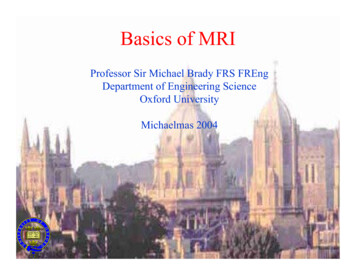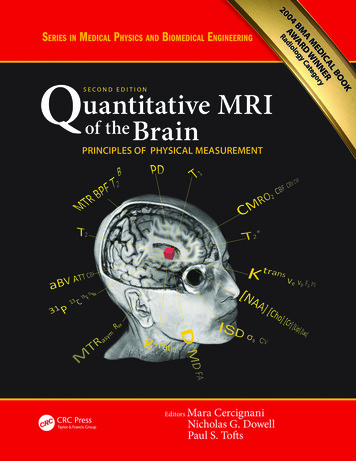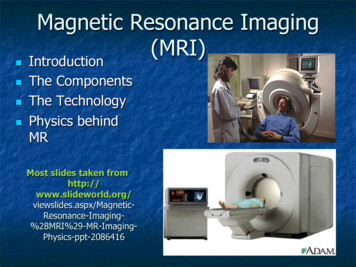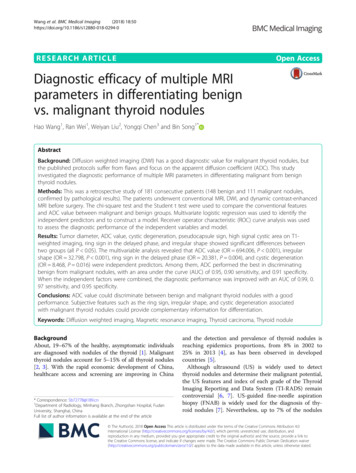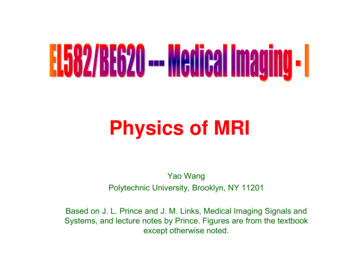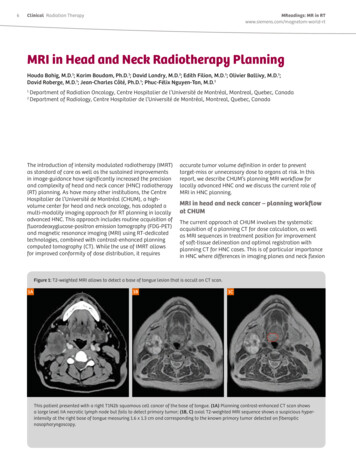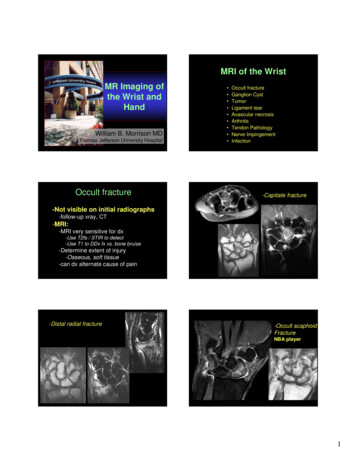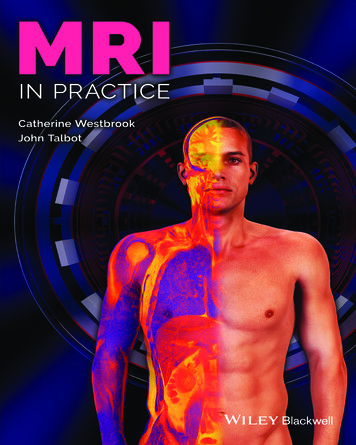
Transcription
MRI in Practice
MRI in PracticeFifth EditionCatherine WestbrookEdD, MSc, FHEA, PgC (Learning & Teaching), DCRR, CTCSenior LecturerAnglia Ruskin UniversityCambridgeUKJohn TalbotEdD, MSc, FHEA, PgC (Learning & Teaching), DCRRSenior LecturerAnglia Ruskin UniversityCambridgeUK
This edition first published 2019 2019 John Wiley & Sons LtdEdition HistoryBlackwell Science (1e, 1993, 2e, 1998); Blackwell Publishing Ltd (3e, 2005, 4e 2011).All rights reserved. No part of this publication may be reproduced, stored in a retrieval system, or transmitted, in any form or byany means, electronic, mechanical, photocopying, recording or otherwise, except as permitted by law. Advice on how to obtainpermission to reuse material from this title is available at http://www.wiley.com/go/permissions.The right of Catherine Westbrook and John Talbot to be identified as the authors of this work has been asserted in accordancewith law.Registered OfficesJohn Wiley & Sons, Inc., 111 River Street, Hoboken, NJ 07030, USAJohn Wiley & Sons Ltd, The Atrium, Southern Gate, Chichester, West Sussex, PO19 8SQ, UKEditorial Office9600 Garsington Road, Oxford, OX4 2DQ, UKFor details of our global editorial offices, customer services, and more information about Wiley products visit us atwww.wiley.com.Wiley also publishes its books in a variety of electronic formats and by print-on-demand. Some content that appears in standardprint versions of this book may not be available in other formats.Limit of Liability/Disclaimer of WarrantyThe contents of this work are intended to further general scientific research, understanding, and discussion only and are notintended and should not be relied upon as recommending or promoting scientific method, diagnosis, or treatment by physiciansfor any particular patient. In view of ongoing research, equipment modifications, changes in governmental regulations, andthe constant flow of information relating to the use of medicines, equipment, and devices, the reader is urged to review andevaluate the information provided in the package insert or instructions for each medicine, equipment, or device for, among otherthings, any changes in the instructions or indication of usage and for added warnings and precautions. While the publisherand authors have used their best efforts in preparing this work, they make no representations or warranties with respect to theaccuracy or completeness of the contents of this work and specifically disclaim all warranties, including without limitationany implied warranties of merchantability or fitness for a particular purpose. No warranty may be created or extended by salesrepresentatives, written sales materials or promotional statements for this work. The fact that an organization, website, orproduct is referred to in this work as a citation and/or potential source of further information does not mean that the publisherand authors endorse the information or services the organization, website, or product may provide or recommendations it maymake. This work is sold with the understanding that the publisher is not engaged in rendering professional services. The adviceand strategies contained herein may not be suitable for your situation. You should consult with a specialist where appropriate.Further, readers should be aware that websites listed in this work may have changed or disappeared between when this workwas written and when it is read. Neither the publisher nor authors shall be liable for any loss of profit or any other commercialdamages, including but not limited to special, incidental, consequential, or other damages.Library of Congress Cataloging-in-Publication DataNames: Westbrook, Catherine, author. Talbot, John (Writer on magneticresonance imaging), author.Title: MRI in practice / by Catherine Westbrook, John Talbot.Description: Fifth edition. Hoboken, NJ : Wiley, 2018. Includesbibliographical references and index. Identifiers: LCCN 2018009382 (print) LCCN 2018010644 (ebook) ISBN9781119391999 (pdf) ISBN 9781119392002 (epub) ISBN 9781119391968(pbk.)Subjects: MESH: Magnetic Resonance Imaging–methods Magnetic ResonanceImaging–instrumentationClassification: LCC RC78.7.N83 (ebook) LCC RC78.7.N83 (print) NLM WN 185 DDC 616.07/548–dc23LC record available at https://lccn.loc.gov/2018009382Cover image: Courtesy of John TalbotCover design by WileySet in 10/12pt TradeGothicLTStd by Aptara Inc., New Delhi, India10 9 8 7 6 5 4 3 2 1
ContentsPreface to the Fifth Edition ixAcknowledgments xiAcronyms xiiiNomenclature xviiAbout the Companion Website xixChapter 1Basic principles1Introduction1Atomic structure2Precession and precessional(Larmor) frequency10Motion in the atom2Precessional phase13MR-active nuclei4Resonance13The hydrogen nucleus5MR signal18Alignment6The free induction decay (FID) signal20Net magnetic vector (NMV)8Pulse timing parameters22Chapter 2Image weighting and contrast24Introduction24Relaxation in different tissues32Image contrast25T1 contrast36Relaxation25T2 contrast40T1 recovery26Proton density contrast41T2 decay27Weighting42Contrast mechanisms31Other contrast mechanisms51
Contents viChapter 3MRI in PracticeSpin-echo pulse sequences58Introduction58Inversion recovery (IR)78RF rephasing59Short tau inversion recovery (STIR)82Conventional spin-echo65Fluid attenuated inversion recovery (FLAIR)84Fast or turbo spin-echo (FSE/TSE)68Chapter 4Gradient-echo pulse sequences89Introduction89Incoherent or spoiled gradient-echo109Variable flip angle90Reverse-echo gradient-echo113Gradient rephasing91Balanced gradient-echo119Weighting in gradient-echo pulse sequences 94Fast gradient-echo122Coherent or rewound gradient-echoEcho planar imaging122106Spatial encodingChapter 5128Introduction128Frequency encoding142Mechanism of gradients129Phase encoding145Gradient axes134Slice-selection135Bringing it all together – pulsesequence timing152Chapter 6k-Space158Introduction158Part 1: What is k-space?Part 2: How are data acquired and howare images created from these data?Chapter 7159Part 3: Some important facts aboutk-space!184165Part 4: How do pulse sequences fillk-space?197Part 5: Options that fill k-space199Protocol optimization209Introduction209Scan time237Signal-to-noise ratio (SNR)210Trade-offs238Contrast-to-noise ratio (CNR)226Spatial resolution232Protocol development andmodification238
MRI in Practice ContentsChapter 8Artifacts242Introduction242Shading artifact276Phase mismapping243Moiré artifact277Aliasing253Magic angle279Chemical shift artifact261Equipment faults280Out-of-phase signal cancellation265Flow artifacts280Magnetic susceptibility artifact269Truncation artifact272Flow-dependent (non-contrastenhanced) blood imaging303Zipper artifact275Phase-contrast MRA304Chapter 9Instrumentation311Introduction311Shim system328Magnetism313Gradient system330Scanner configurations315RF system337Magnet system318Patient transport system343Magnet shielding326Computer system and graphical userinterface344Chapter 10MRI Safety346Introduction (and disclaimer)346Time-varying gradient magnetic fields 363Definitions used in MRI safety347Cryogens365Psychological effects350Safety tips367The spatially varying static field351Additional resources368Electromagnetic (radiofrequency) fields 357Glossary Index 370387vii
Preface to thefifth editionThe MRI in Practice brand continues to grow from strength to strength. The fourth edition of MRIin Practice is an international best-seller and is translated into several languages. At the time ofwriting, the accompanying MRI in Practice course is 26 years old. We have delivered the courseto more than 10 000 people in over 20 countries and have a large and growing MRI in Practiceonline community. Our readers and course delegates include a variety of professionals such asradiographers, technologists, radiologists, radiotherapists, veterinary practitioners, nuclear medicine technologists, radiography students, postgraduate students, medical students, physicists,and engineers.The unique selling point of MRI in Practice has always been its user-friendly approach tophysics. Difficult concepts are explained as simply as possible and supported by clear diagrams,images, and animations. Clinical practitioners are not usually interested in pages of math and justwant to know how it essentially “all works.” We believe that MRI in Practice is so popular becauseit speaks your language without being oversimplistic.This fifth edition has had a significant overhaul and specifically plays to the strengths of theMRI in Practice brand. We have created a synergy between the book and the course so that theyare best able to support your learning. We purposefully focus on physics in this edition and onessential concepts. It is important to get the fundamentals right, as they underpin more specialistareas of practice. There are completely new chapters on MRI equipment and safety, and substantially revised and expanded chapters on gradient-echo pulse sequences, k-space, artifacts, andangiography. The very popular learning tips and analogies from previous editions are expandedand revised. There is also a new glossary, lots of new diagrams and images, and suggestionsfor further reading for those who wish to delve deeper into physics. The accompanying website includes new questions and additional animations. We also include some equations in thisedition, but don’t worry: they are there only for those who like equations, and we explain whatthey mean in a user-friendly style.However, probably the most significant change in this edition is the inclusion of scan tips.Throughout the book, your attention is drawn to how theory applies to practice. Scan tips are specifically used to alert you to what is going on “behind the scenes” when you select a parameterin the scan protocol. We hope this helps you make the connection between theory and practice.Physics in isolation is of little value to the clinical practitioner. What is important is how thisknowledge is applied. We stand by the MRI in Practice philosophy that physics does not have tobe difficult, and we hope that our readers, old and new, find these changes helpful. Richard Feynman,who is considered one of the finest physics teachers of all time, was renowned for his ability
Preface xMRI in Practiceto transfer his deep understanding of physics to the page with clarity and a minimum of fuss. Hebelieved that it is unnecessary to make physics more complicated than it need be. Our aspirationis that the fifth edition of MRI in Practice emulates his way of thinking.We hope that the many fans of MRI in Practice around the world continue to enjoy and learnfrom it. A big thank you for your continued support and happy reading!Catherine WestbrookJohn TalbotNovember 2017United Kingdom
AcknowledgmentsMany thanks to all my loved ones for their continued support, especially Maggie Barbieri (mymother, whose brain scans feature many times in all the editions of this book and in the MRI inPractice course for the last 26 years. She must have the most viewed brain in the world!), FrancescaBellavista, Amabel Grant, Adam, Ben and Maddie Westbrook.Catherine WestbrookI’d like to thank my family Dannie, Joey, and Harry for bringing coffee, biscuits, and occasionallygin and tonic. I would also like to take the opportunity to acknowledge the work of a great MRIpioneer, Prof. Sir Peter Mansfield, who died this year. Prof. Mansfield’s team created the firsthuman NMR image in 1976, and he kindly shared all of his most important research papers withme when I first started writing about this amazing field.John Talbot
oshibaConventional spin-echo (SE)SESESESESETurbo spin-echo (TSE)TSEFSETSEFSEFSESingle-shot TSE (SS-TSE)HASTESS-FSESS-TSESS-FSEFASETSE (with restoration pulse)RESTOREFRFSEDRIVEdrivenequilibrium FSET2 Puls FSEInversion recovery (IR)IRIR/MPIRIRIRIRFast inversion recoveryTIRFast IRIR-TSEIRIRShort tau IR (STIR)STIRSTIRSTIRSTIRfast STIRFluid-attenuated IR (FLAIR)turbo dark fluidFLAIRFLAIRFLAIRfast FLAIRGradient-echo (GRE)GREGREFFEGEfield echoCoherent gradient-echoFISPGRASSFFErephased SARGESSFPIncoherent gradient-echoFLASHSPGRT1 FFEspoiled SARGEfast FEReverse-echo gradient-echoPSIFSSFPT2 FFEtime-reversedSARGE—Balanced gradient-echotrue FISPFIESTABFFEbalanced SARGEtrue SSFPEcho-planar imaging (EPI)EPIEPIEPIEPIEPIDouble-echo steady stateDESS————Balanced dual excitationCISSFIESTA-C—phase EDICMERGEMFFE——Fast gradient-echoturbo FLASHfast GRE, fastSPGRTFERGEFast FEHybrid sequenceTGSE—GRASE—Hybrid EPIPulse sequences
Acronyms xivGenericMRI in PracticeSiemensGEPhilipsHitachiToshibaRepetition time (TR)TRTRTRTRTRTime to echo (TE)TETETETETETime from inversion (TI)TITITITITIFlip angleflip angleflip angleflip angleflip angleFlip angleNumber of echoes (in TSE)turbo factorETLturbo factorshot factorETLb factor/valueb factorb factorb factorb factorb factorField of view (FOV)FOV (mm)FOV (cm)FOV (mm)FOV (mm)FOV (mm)Rectangular FOVFOV phasePFOVrectangularFOVrectangular FOVrectangularFOVSlice gapdistance factorgapgapslice dwidth (Hz/pixel)receivebandwidth(KHz)fat watershift (pixel)bandwidth (KHz)bandwidth(KHz)Variable al averaginghalf Fourierfractional NEXhalf scanhalf scanAFIPartial echoasymmetricechopartial echopartial echohalf echomatchedbandwidthParallel imaging (image based)mSENSEASSETSENSERAPIDSPEEDERParallel imaging (k-space based)GRAPPAARC———Radial k-space fillingBLADEPROPELLORmultiVaneRADARJETGradient moment rephasingGMR/flowcompflow compflow comp/FLAGGRFCPresaturationpre SATSatRESTPre SATPre SATMoving sat pulsetravel SATwalking SATtravel RESTSequential preSATBFASTFat saturationfat SATchem SATSPIRFat SatMSOFTOut-of-phase imagingDIXONIDEALProSETWater excitationPASTARespiratory nPEARMARrespiratorygatedAntialiasing nAntialiasing (phase)phaseoversamplingno phase wrapfold-oversuppressionantiwrapphase wrapsuppressionContrast parametersGeometry parametersData acquisition parametersArtifact reduction techniques
MRI in Practice e TSE variable flip angleSPACECUBEVISTA——Volume gradient-echoVIBELAVA-XVTHRIVETIGRE—Dynamic MRATWISTTRICKS-SVkeyhole (4dTrak)——Noncontrast MRA gradient-echoNATIVE – trueFISPinhance inflowIRB-TRANCEVASC ASLTIME-SLIPNoncontrast MRA spin- echoNATIVE-SPACE—TRANCEVASC FSEFBISusceptibility weightingSWISWANVenous BOLD——High-resolution breast ighted imagingDWIDWIDWIDWIDWIDiffusion tensor imagingDTIDTIdiffusiontensorimaging—DTIBody diffusion imagingREVEAL—DWIBS—body visionSpecial techniquesxv
NomenclatureSspin quantum numberNnumber of spins in the high-energy population (Boltzmann)Nnumber of spins in the low-energy population (Boltzmann)ΔEenergy difference between high- and low-energy populations (Boltzmann)JkBoltzmann’s constantJ/KTtemperature of the tissueKω0precessional or Larmor frequencyMHzγgyromagnetic ratioMHz/TB0external magnetic field strengthTEenergy of a photonJhPlanck’s constantJ/sθflip angle ω1precessional frequency of B1μT B1magnetic field associated with the RF excitation pulsemTτduration of the RF excitation pulsemsϵemfVNnumber of turns in a coildΦchanging magnetic flux in a single loopV/sdtchanging timesMztamount of longitudinal magnetization at time tMzfull longitudinal magnetizationMxytamount of transverse magnetization at time tMxyfull transverse magnetizationSIsignal intensity in a tissueΔB0variation in magnetic fieldppmGgradient amplitudemT/mδgradient durationmsΔtime between two gradient pulsesms
Nomenclature xviiiMRI in Practicebb value or b factors/mm2STscan timesESecho spacing in turbo spin-echo (TSE)msttime from inversion (TI)msErnstErnst angle TEeffeffective TEmsTEactTE set at the consolemsBpmagnetic field strength at a point along the gradientTSltslice thicknessmmTBWtransmit bandwidthKHzωsamplingdigital sampling frequencyKHzΔTssampling intervalmsωNyquistNyquist frequencyKHzRBWreceive bandwidthKHzWssampling windowmsM(f)frequency matrixM(p)phase matrixNsnumber of slice locationsG(p)max amplitude of the phase encoding gradientϕincremental step between each k-space lineG(f)amplitude of the frequency encoding gradientmT/mFOV(f)frequency FOVcmσstandard deviation of background signal or noiseSpseparation between ghosts due to motion ppixelsTmperiod of motion of something moving in the patientmsReReynolds numberddensity of bloodg/cm3vvelocity of flowcm/smdiameter of a vesselcmvisviscosity of bloodg/cm sfpperceived frequencyKHzftactual frequencyKHzωcsfchemical shift frequency difference between fat and waterHzCschemical shift (3.5 ppm or 3.5 10 6)ppmCSppixel shiftmmH0magnetic intensityA/mqcharge of a particleCFLorentz force (total emf on a charged particle)VEelectric field vectorBmagnetic field vectormT/m
MatterTitleAboutthe companionwebsiteThis book is accompanied by a companion e website includes: Brand new 3D animations of more complex concepts from the book 100 short-answer questions to aid learning and understanding.
1Basic principlesIntroduction1Atomic structure2Precession and precessional(Larmor) frequency10Motion in the atom2Precessional phase13MR-active nuclei4Resonance13The hydrogen nucleus5MR signal18Alignment6The free induction decay (FID) signal20Net magnetic vector (NMV)8Pulse timing parameters22After reading this chapter, you will be able to: Describe the structure of the atom. Explain the mechanisms of alignment and precession. Understand the concept of resonance and signal generation.IntroductionThe basic principles of magnetic resonance imaging (MRI) form the foundation for furtherunderstanding of this complex subject. It is important to grasp these ideas before moving on tomore complicated topics in this book.There are essentially two ways of explaining the fundamentals of MRI: classically and viaquantum mechanics. Classical theory (accredited to Sir Isaac Newton and often called Newtoniantheory) provides a mechanical view of how the universe (and therefore how MRI) works. Usingclassical theory, MRI is explained using the concepts of mass, spin, and angular momentum ona large or bulk scale. Quantum theory (accredited to several individuals including Max Planck,Albert Einstein, and Paul Dirac) operates at a much smaller, subatomic scale and refers to theenergy levels of protons, neutrons, and electrons. Although classical theory is often used todescribe physical principles on a large scale and quantum theory on a subatomic level, thereis evidence that all physical principles are explained using quantum concepts [1]. However, forour purposes, this chapter mainly relies on classical perspectives because they are generallyeasier to understand. Quantum theory is only used to provide more detail when required.MRI in Practice, Fifth Edition. Catherine Westbrook and John Talbot. 2019 John Wiley & Sons Ltd. Published 2019 by John Wiley & Sons Ltd.Companion Website: www.wiley.com/go/westbrook/mriinpractice
Chapter 1 2MRI in PracticeIn this chapter, we explore the properties of atoms and their interactions with magnetic fieldsas well as the mechanisms of excitation and relaxation.Atomic structureAll things are made of atoms. Atoms are organized into molecules, which are two or more atomsarranged together. The most abundant atom in the human body is hydrogen, but there are otherelements such as oxygen, carbon, and nitrogen. Hydrogen is most commonly found in molecules ofwater (where two hydrogen atoms are arranged with one oxygen atom; H2O) and fat (where hydrogenatoms are arranged with carbon and oxygen atoms; the number of each depends on the type of fat).The atom consists of a central nucleus and orbiting electrons (Figure 1.1). The nucleus is verysmall, one millionth of a billionth of the total volume of an atom, but it contains all the atom’smass. This mass comes mainly from particles called nucleons, which are subdivided into protonsand neutrons. Atoms are characterized in two ways. The atomic number is the sum of the protons in the nucleus. This number gives an atom itschemical identity. The mass number or atomic weight is the sum of the protons and neutrons in the nucleus.The number of neutrons and protons in a nucleus is usually balanced so that the mass number is aneven number. In some atoms, however, there are slightly more or fewer neutrons than protons.Atoms of elements with the same number of protons but a different number of neutrons arecalled isotopes.Electrons are particles that spin around the nucleus. Traditionally, this is thought of as analogous to planets orbiting around the sun with electrons moving in distinct shells. However, according to quantum theory, the position of an electron is not predictable as it depends on the energyof an individual electron at any moment in time (this is called Heisenberg’s Uncertainty Principle).Some of the particles in the atom possess an electrical charge. Protons have a positive electricalcharge, neutrons have no net charge, and electrons are negatively charged. Atoms are electricallystable if the number of negatively charged electrons equals the number of positively chargedprotons. This balance is sometimes altered by applying energy to knock out electrons from theatom. This produces a deficit in the number of electrons compared with protons and causeselectrical instability. Atoms in which this occurs are called ions and the process of knocking outelectrons is called ionization.Motion in the atomThree types of motion are present within the atom (Figure 1.1): Electrons spinning on their own axis Electrons orbiting the nucleus The nucleus itself spinning about its own axis.The principles of MRI rely on the spinning motion of specific nuclei present in biological tissues. There are a limited number of spin values depending on the atomic and mass numbers. Anucleus has no spin if it has an even atomic and mass number, e.g. six protons and six neutrons,mass number 12. In nuclei that have an even mass number caused by an even number of protons and neutrons, half of the nucleons spin in one direction and half in the other. The forces ofrotation cancel out, and the nucleus itself has no net spin.
Chapter 1Basic principles Spin (up)3“Orbit”Spin (down)Neutron (no charge)Proton (positive)Electron (negative)NucleusSpinSpinNet spinFigure 1.1 The atom.
Preface to the fifth edition The MRI in Practice brand continues to grow from strength to strength. The fourth edition of MRI in Practice is an international best-seller and is translated into several languages. At the time of writing, the accompanying MRI in Practice course is 26 years old. We have delivered the course to more than 10 000 people in over 20 countries and have a large
